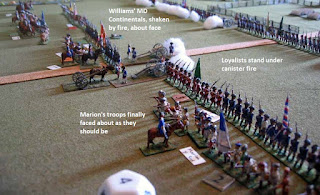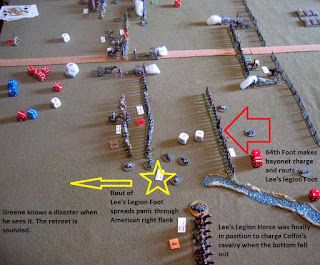One more time… this is the last
Eutaw Springs game and the last Loose Files game for this year. The game ended
in a complete surprise to me but I much prefer this version of the rules. I
used Andy Callan’s “Paperboys Peninsular War Rules” to determine who fights in
combat and how multiple unit combats are divided up. I junked the vague reference
to orders a while back. Last, I tried the card activation method from the
Paperboys rules. Each side has three cards in the deck, 3 red (for the British)
and 3 black for the Yanks. Your first card is when you fire, the second card is
when your cavalry moves, the third card is when your infantry and artillery move.
Leaders can move on any card. Combat is resolved at the end of each movement phase.
Retreats and routs are done immediately
after combat. After all cards are done, both sides rally. It works well. I suggest yellow markers to show a unit can't move for a turn and red for routs.
This time the deployment photo is behind the British. It must have given them a rush, for their dice were hot. And I bungled the Americans.
Lee’s Legion will fall back, about face and move back a little. If you pull troops out of the line to reorganize, take them all the way out. Taught myself a lesson. Pickens and Malmedy both were disorganized by musket fire and decide to fall back through the regulars.
The Maryland Continentals moved forward to cover the militia and were met by a blast of fire. They about-faced and started to move off. The British wanted to charge but could not fire and move in the same turn.
But on the next turn the British infantry move card came up first. The 3rd Foot could not fire since Williams had moved out of range, but the movement dice allowed them to charge and hit the badly disorganized Marylanders in the rear. Ouch.
On the American right, the 64th Foot charged and caught Lee’s Legion Foot reorganizing, facing the wrong way. As stated earlier, they should have fallen back further to rally. Instead they were routed. In these rules, good units routing cause infectious disorder and desertion among friends within 6”. Almost everyone who wasn’t within 6” of the Maryland rout were within 6” of Lee’s Legion. It was over. The army was a wreck.
It took about 90 minutes to play
5 turns. American losses were extremely high, 21 stands of infantry and 3 of cavalry,
about 414. Many of these were either prisoners or troops who bolted due to
panic. British losses? One stand of infantry in the first fight with Lee’s
legion Foot. Taking into account the 400 British foragers snapped up before the battle, both sides
were even but the repulse was humiliating.
In spite of this I was quite pleased with the way the rules worked. The card system removes any possible problems arising from simultaneous movement. If you’ve played such in the past, you know; “if you do this then I do that”. I recall some dreadful rows about such things. This is way better. Your card comes up, put up or shut up. Having the cavalry move on their own card makes coordination much harder. I might steal one more thing from the Paperboys rules: troops are only affected by the retreat of their own arms. So, infantry think nothing of cavalry clattering past to the rear and vice versa. But when your own sort gives way, look out.










8 comments:
I like that idea! I’ve toyed with using cards from my ACW rules but this looks pretty good to me. Thanks for doing this it’s been really interesting and very useful. 👍
Thank you for your help on this.
Splendid (and bloody) lines of battle, sounds great!
That’s a great looking set-up you have there. What figures are you using?
The figures are Fryingpan & Blanket, true 20mm figures (not 1/72). They don't have a web presence beyond that established by fans. You have to order by snail mail. I like the figures but if I had to do it all over again 15mm would be my choice, since almost everything else in my collection is that scale. I do not intend to redo it.
Great looking game. Five turns in 90 minutes; you were fairly motoring!
Another method of card-based activation is by organisational structure (brigade or such), but I am sure that you know that already. Piquet used the method that you have adopted, but Fields of Battle* (and subsequent sets that adopted the mechanic) seem to go more by army organisation, I think.
Regards, James
(*There's an excellent, detailed play-through of a recent, solo, Field of Battle game on Peter 'Gonsalvo' Anderson's 'Blunders on the Danube' blog. YOu may already know of this too, of course!)
Thanks James. These armies are a tad small for the British brigade/American Division approach.
If and when I revisit Camden that should be a candidate for that method.
I'll have to check Blunders on the Danube, been too long since I wandered over there.
Thanks for your battle reports using Loose Files. I am currently reviewing which AWI rules I want to use myself and very much coming down to choosing Loose Files with tweaks. It’s reassuring to see you fighting such great battles using them ! I plan to practice a few solo battles (my collection is geared towards Guilford Courthouse ) and clarify exactly how I want to adapt them. As you mention I think it’s more about needing clarity rather than overcomplication. Cheers again and looking forward to your next game ! Simon
Post a Comment